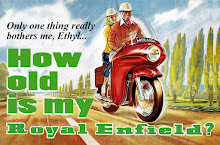 It's always great to hear from other people fascinated with Royal Enfield motorcycles and one of the most interesting people I hear from is "Fuji."
It's always great to hear from other people fascinated with Royal Enfield motorcycles and one of the most interesting people I hear from is "Fuji."Fuji turns out to be Eriberto P. Lozada Jr., associate professor of anthropology and director of Asian studies at Davidson College, in Davidson, N.C.
He presents the case for an anthropologist's interest in Royal Enfields on his blog, Fuji Lozada'sFieldnotes :
 "So after Enfield went out of business, the Indian factory continued to crank out 1955 Bullets, into the 21st century. Now this Indian company is exporting a British classic all over the world, including back into the U.K. and to the United States. So what we have here is a story similar to cricket, as described by Arjun Appadurai and many others, of a cultural item being exported along the British colonial lines, and then being re-imported back into its origin, or there-and-back globalization. This classic British motorcycle is now truly Indian, retaining a lot of its familiar British style, but with modern Indian engineering."
"So after Enfield went out of business, the Indian factory continued to crank out 1955 Bullets, into the 21st century. Now this Indian company is exporting a British classic all over the world, including back into the U.K. and to the United States. So what we have here is a story similar to cricket, as described by Arjun Appadurai and many others, of a cultural item being exported along the British colonial lines, and then being re-imported back into its origin, or there-and-back globalization. This classic British motorcycle is now truly Indian, retaining a lot of its familiar British style, but with modern Indian engineering."Buying a Royal Enfield comes under the title "Practicing What I Research." The black Royal Enfield G5 pictured above is his.
"I was able to ride my Enfield yesterday here in North Carolina — no snow!" he rejoiced Wednesday.
Lozada's blog identifies him as a former Marine officer and a college and high school lacrosse official. A Masters of Theological Studies candidate at the Harvard Divinity School, he received his M.A. in Regional Studies: East Asia at Harvard University. Then came his Ph.D. in social anthropology from Harvard.
"I bought my first motorcycle, a 1977 Honda 360T with a kick-starter (since the electric starter was on-and-off) in 1984, and always kept a bike to get around places with difficult parking (like Boston). I bought my first new motorcycle in 1986: a Honda Nighthawk S CB700SC – back then, I was deciding between the Honda and a BMW R60 (a mid-size boxer engine), and the hydraulic everything on the Honda won out. I did have instant buyer’s remorse – and promised that my next bike would be a BMW.
"I got rid of that 1986 Honda and have missed riding – especially in the south, where I can ride all year (it was harder to ride year-round in Boston, but I did it when I was young and foolish). So a few months ago, I started to again look at motorcycles, to see what is around. The standards that I prefer seem to have gotten bigger; the BMW boxer that I have pined over since 1986 are only available in a 1200cc version. They have also gotten a lot more expensive – the BMW R1200R is around $14,000, the price of a car.
"That’s when I ran into the Royal Enfield."
His field notes remind us that it's important for peoples to understand one another, in part so we can compete more effectively in the global economy.
"More than ever before, understanding culture is an important skill for college students to pick up before they leave college. Culture, as any anthropology class will tell you, is the crucial foundation from which to understand how things work in different societies. Understanding how culture works in social relations is vital to working cross-culturally."
The professor ("please call me Fuji") hopes to find out more about Royal Enfield. "With its factory in Chennai, where Davidson has its India program, I hope to someday visit and see this production of nostalgia for myself," he writes.
































No comments:
Post a Comment